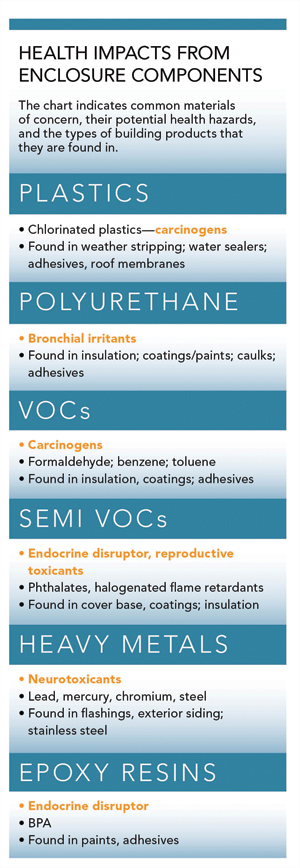Designed, Sealed, Delivered - IAQ and the Building Enclosure
The Building Enclosure/IAQ Relationship
We often hear that people commonly spend 85 to 90 percent of their time indoors, meaning that they are primarily breathing the air from inside buildings. That indoor air is contained and directly influenced by the building enclosure. It is also common to hear that the indoor air quality (IAQ) in many buildings is worse than the outdoor air quality. This is usually because building occupants are exposed within the enclosure to a mix of pollutants including complex indoor chemicals and other irritants such as dust, pollen, mold, and VOCs. Surprisingly, many of these indoor air pollutants are only measured but not regulated by the U.S. Environmental Protection Agency (EPA) like they are for outdoor air contaminants.
 |
Source: The Center for Health Design® and Health Care Without Harm, Designing the 21st Century Hospital |
Direct Pollutant Sources
While there has been plenty of attention paid to things like carpeting, furniture, interior finishes, and other materials related to IAQ, the building enclosure has been found to be a significant contributor to indoor air pollutants as well. Depending on the materials used and the assembly design, the building enclosure can exclude, release, or trap pollutants or it can be a possible source of pollutants itself. These pollutants may include:
- VOCs. According to the U.S. EPA, most sources of indoor air pollution come from materials and products that “off gas” or emit VOCs after they are installed. In the building enclosure, sources can include manufactured wood products, adhesives, sealants, caulks, paints, coatings, surfacing, cladding, insulation, air barriers, and even wall board. When the VOCs off gas into the enclosure assembly they are basically airborne and may remain suspended there. However, once any air, moisture, or pressure infiltration occurs, these VOCs can start to move with that infiltration and be transferred to the building interior.
- Formaldehyde. The construction industry is the primary end-user of formaldehyde-based products, representing 70 percent of its use overall. Just like VOCs when formaldehyde outgasses in a building enclosure system, it can be impacted by air or moisture infiltration and permeate into the interior of the building.
- Particulate matter (PM). Dust or other particles can become trapped or built up inside an enclosure assembly. A breach in the assembly or an air infiltration point can move that PM through the open spaces and discharge into the building where it is airborne and accessible to the occupants.
- Plastics. The use of petroleum-based plastics in buildings is widespread and in some cases, growing. This includes foam plastics used for insulation, plasticizers used in certain materials, and solid plastics used for a wide variety of products. As such, plastics are coming to be seen as one of largest health offenders in buildings today. It is important to understand, however that there is a range of safety or harmfulness depending on the particular plastic used. Polyvinyl chloride (PVC) or plastics with hazardous additives are clearly less environmentally preferable. By contrast, bio-based plastics and compounds such as polyethylene, polypropylene, and thermal polyolefin, are much more preferable.
- Persistent bio-accumulative toxins (PBTs). This is a class of contaminants found in various envelope materials such as flame retardants and anti-microbials. The EPA describes PBT pollutants as chemicals that are toxic, persist in the environment, and bioaccumulate in food chains and, thus, pose risks to human health and ecosystems. The biggest concerns about PBTs are that they transfer rather easily among air, water, and land, and span boundaries of programs, geography, and generations.
- Moisture. The right amount of moisture in indoor air is desirable, but when moisture is allowed to pass into an enclosure assembly, it can exacerbate conditions related to IAQ. For example, it may create mold if there is an organic food source material available or its presence on formaldehyde-containing materials may actually increase formaldehyde emissions.









